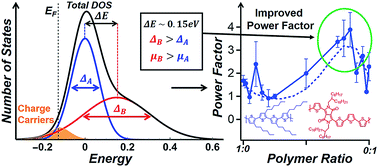Designing π-conjugated polymer blends with improved thermoelectric power factors†
Abstract
Blending two or more π-conjugated polymers together provides a means of manipulating charge transport properties and potentially improving the performance of organic thermoelectrics. Previous results have shown that π-conjugated polymer blends can display higher Seebeck coefficients than either of the individual polymers; however, significantly increased power factors and improved thermoelectric performance in polymer blends as compared to the individual polymers has not yet been demonstrated. The purpose of this work is to theoretically and experimentally probe how the electronic properties of the individual polymers influence the Seebeck coefficient, electrical conductivity, and power factor in polymer blends. Specifically, the influence of energetic disorder, energy offsets between the transport states in the two polymers, and charge-carrier localization lengths are investigated based on a theoretical model introduced by Arkhipov and Bässler. These calculations show that gains in the power factor should be attainable when the two polymers have a small (e.g., 0.1–0.2 eV) offset in their density of states (DOS) distributions and the polymer with the higher energy DOS has a wider DOS distribution and a larger localization length. Experimentally, power factors in an appropriate polymer blend are demonstrated to exceed the power factors of the individual polymers by nearly two-fold. Through the applied theoretical and experimental approach, this work provides guidance in regards to the energetics, density of states, and charge-carrier mobilities for designing higher performing organic thermoelectrics with π-conjugated polymer blends.



 Please wait while we load your content...
Please wait while we load your content...